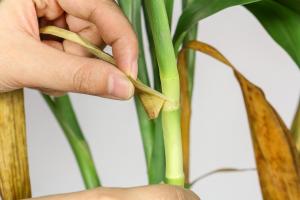Introduction
Tomatoes are some of the most commonly grown vegetables in home gardens. As they grow, these plants may become too heavy for their stems to support, causing them to collapse. One way to prevent this is by using twine to support the plants. This article will provide a comprehensive guide on how to support tomato plants with twine.
Choosing the Right Twine
Before you begin tying up your tomato plants, it is important to choose the right twine. Look for twine that is durable and strong enough to support the weight of the plants. Many garden centers sell special tomato twine that is strong and stretchy. However, you can also use any type of twine or string as long as it’s strong enough to support the weight of your plants.
Preparing the Tomato Plants
Before you start tying your tomato plants, you need to prepare them first. Remove all the lower leaves from the stem of the plant, leaving only the top few leaves. This will help prevent any leaves from being damaged or blocked by the twine as it grows.
Setting up the Twine
To set up the twine, start by driving a tall stake into the ground at least 18 inches deep next to each tomato plant. The stake should be made of sturdy wood or metal and should be able to support the weight of the plant. Tie the twine to the stake at the base of the tomato plant, then wrap the twine loosely around the plant in a spiral pattern as it grows taller. Tie the top of the twine to the stake, making sure the twine is taut but not too tight.
Adjusting the Twine
As the tomato plant grows, you will need to adjust the twine to accommodate its increasing height and weight. Every few weeks, check your plants and adjust the twine as needed. This will help prevent the plants from becoming too heavy and breaking the stems.
Benefits of Using Twine to Support Tomato Plants
Using twine to support your tomato plants is beneficial in several ways. Firstly, it helps to prevent damage to the plants by supporting their weight and preventing them from collapsing. Secondly, it helps to keep the plants upright, allowing for better sun exposure and air circulation. Lastly, it helps to keep the fruit off the ground, reducing the risk of rot and allowing for easier harvesting.
Conclusion
By using twine to support your tomato plants, you can help them grow stronger and healthier, while also reducing the risk of damage and disease. Choose the right twine, prepare your plants, set up the twine correctly, and adjust it as needed. By following these steps, you can enjoy a bountiful harvest of delicious homegrown tomatoes.

 how many times do yo...
how many times do yo... how many planted tre...
how many planted tre... how many pine trees ...
how many pine trees ... how many pecan trees...
how many pecan trees... how many plants comp...
how many plants comp... how many plants can ...
how many plants can ... how many plants and ...
how many plants and ... how many pepper plan...
how many pepper plan...
































